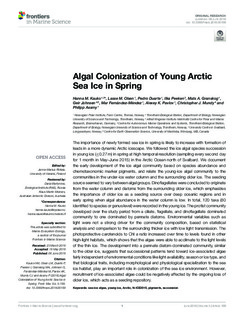| dc.contributor.author | Kauko, Hanna Maria | |
| dc.contributor.author | Olsen, Lasse Mork | |
| dc.contributor.author | Duarte, Pedro | |
| dc.contributor.author | Peeken, Ilka | |
| dc.contributor.author | Granskog, Mats A. | |
| dc.contributor.author | Johnsen, Geir | |
| dc.contributor.author | Fernández-Méndez, Mar | |
| dc.contributor.author | Pavlov, Alexey | |
| dc.contributor.author | Mundy, Christopher John | |
| dc.contributor.author | Assmy, Philipp | |
| dc.date.accessioned | 2019-03-06T07:53:41Z | |
| dc.date.available | 2019-03-06T07:53:41Z | |
| dc.date.created | 2018-07-30T20:58:34Z | |
| dc.date.issued | 2018 | |
| dc.identifier.citation | Frontiers in Marine Science. 2018, 5 . | nb_NO |
| dc.identifier.issn | 2296-7745 | |
| dc.identifier.uri | http://hdl.handle.net/11250/2588912 | |
| dc.description.abstract | The importance of newly formed sea ice in spring is likely to increase with formation of leads in a more dynamic Arctic icescape. We followed the ice algal species succession in young ice (≤ 0.27 m) in spring at high temporal resolution (sampling every second day for 1 month in May–June 2015) in the Arctic Ocean north of Svalbard. We document the early development of the ice algal community based on species abundance and chemotaxonomic marker pigments, and relate the young-ice algal community to the communities in the under-ice water column and the surrounding older ice. The seeding source seemed to vary between algal groups. Dinoflagellates were concluded to originate from the water column and diatoms from the surrounding older ice, which emphasizes the importance of older ice as a seeding source over deep oceanic regions and in early spring when algal abundance in the water column is low. In total, 120 taxa (80 identified to species or genus level) were recorded in the young ice. The protist community developed over the study period from a ciliate, flagellate, and dinoflagellate dominated community to one dominated by pennate diatoms. Environmental variables such as light were not a strong driver for the community composition, based on statistical analysis and comparison to the surrounding thicker ice with low light transmission. The photoprotective carotenoids to Chl a ratio increased over time to levels found in other high-light habitats, which shows that the algae were able to acclimate to the light levels of the thin ice. The development into a pennate diatom-dominated community, similar to the older ice, suggests that successional patterns tend toward ice-associated algae fairly independent of environmental conditions like light availability, season or ice type, and that biological traits, including morphological and physiological specialization to the sea ice habitat, play an important role in colonization of the sea ice environment. However, recruitment of ice-associated algae could be negatively affected by the ongoing loss of older ice, which acts as a seeding repository. | nb_NO |
| dc.language.iso | eng | nb_NO |
| dc.publisher | Frontiers | nb_NO |
| dc.rights | Navngivelse 4.0 Internasjonal | * |
| dc.rights.uri | http://creativecommons.org/licenses/by/4.0/deed.no | * |
| dc.title | Algal colonization of young arctic sea ice in spring | nb_NO |
| dc.type | Journal article | nb_NO |
| dc.type | Peer reviewed | nb_NO |
| dc.description.version | publishedVersion | nb_NO |
| dc.source.pagenumber | 20 | nb_NO |
| dc.source.volume | 5 | nb_NO |
| dc.source.journal | Frontiers in Marine Science | nb_NO |
| dc.identifier.doi | 10.3389/fmars.2018.00199 | |
| dc.identifier.cristin | 1599081 | |
| dc.relation.project | Andre: Hemholtz asc. - PACES | nb_NO |
| dc.relation.project | Norges forskningsråd: 244646 | nb_NO |
| dc.relation.project | Utenriksdepartementet: Program Arktis 2030 | nb_NO |
| dc.relation.project | Norges forskningsråd: 221961 | nb_NO |
| dc.relation.project | Norges forskningsråd: 223254 | nb_NO |
| dc.relation.project | Andre: Pol-Nor/197511/40/ 2013 | nb_NO |
| dc.description.localcode | Copyright © 2018 Kauko, Olsen, Duarte, Peeken, Granskog, Johnsen, Fernández-Méndez, Pavlov, Mundy and Assmy. This is an open-access article distributed under the terms of the Creative Commons Attribution License (CC BY). The use, distribution or reproduction in other forums is permitted, provided the original author(s) and the copyright owner are credited and that the original publication in this journal is cited, in accordance with accepted academic practice. No use, distribution or reproduction is permitted which does not comply with these terms. | nb_NO |
| cristin.unitcode | 194,66,10,0 | |
| cristin.unitname | Institutt for biologi | |
| cristin.ispublished | true | |
| cristin.fulltext | original | |
| cristin.qualitycode | 1 | |

